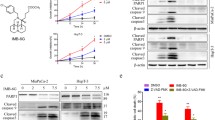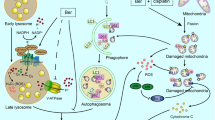Abstract
The autophagy-mediated lysosomal pathway plays an important role in conferring stress tolerance to tumor cells during cellular stress such as increased metabolic demands. Thus, targeted disruption of this function and inducing lysosomal cell death have been proved to be a useful cancer therapeutic approach. In this study, we reported that octyl syringate (OS), a novel phenolic derivate, was preferentially cytotoxic to various cancer cells but was significantly less cytotoxic to non-transformed cells. Treatment with OS resulted in non-apoptotic cell death in a caspase-independent manner. Notably, OS not only enhanced accumulation of autophagic substrates, including lapidated LC3 and sequestosome-1, but also inhibited their degradation via an autophagic flux. In addition, OS destabilized the lysosomal function, followed by the intracellular accumulation of the non-digestive autophagic substrates such as bovine serum albumin and stress granules. Furthermore, OS triggered the release of lysosomal enzymes into the cytoplasm that contributed to OS-induced non-apoptotic cell death. Finally, we demonstrated that OS was well tolerated and reduced tumor growth in mouse xenograft models. Taken together, our study identifies OS as a novel anticancer agent that induces lysosomal destabilization and subsequently inhibits autophagic flux and further supports development of OS as a lysosome-targeting compound in cancer therapy.
Graphical abstract

• Octyl syringate, a phenolic derivate, is preferentially cytotoxic to various cancer cells.
• Octyl syringate destabilizes the lysosomal function.
• Octyl syringate blocks the autophagic flux.
• Octyl syringate is a potential candidate compound for cancer therapy.






Similar content being viewed by others
Data availability
The data that support the findings of this study are available from the corresponding author upon reasonable request.
Code availability
Not applicable.
References
Andersson C, Iresjo BM, Lundholm K. Identification of tissue sites for increased albumin degradation in sarcoma-bearing mice. J Surg Res. 1991;50(2):156–62. https://doi.org/10.1016/0022-4804(91)90240-m.
Apel A, Herr I, Schwarz H, Rodemann HP, Mayer A. Blocked autophagy sensitizes resistant carcinoma cells to radiation therapy. Cancer Res. 2008;68(5):1485–94. https://doi.org/10.1158/0008-5472.CAN-07-0562.
Appelmans F, Wattiaux R, De Duve C. Tissue fractionation studies. 5. The association of acid phosphatase with a special class of cytoplasmic granules in rat liver. Biochem J. 1955;59(3):438–45. https://doi.org/10.1042/bj0590438.
Babson AL, Winnick T. Protein transfer in tumor-bearing rats. Cancer Res. 1954;14(8):606–11.
Bainton DF. The discovery of lysosomes. J Cell Biol. 1981;91(3 Pt 2):66s–76s. https://doi.org/10.1083/jcb.91.3.66s.
Bhat P, Kriel J, Shubha Priya B, Basappa, Shivananju NS, Loos B. Modulating autophagy in cancer therapy: advancements and challenges for cancer cell death sensitization. Biochem Pharmacol. 2018;147:170–82. https://doi.org/10.1016/j.bcp.2017.11.021.
Buchan JR, Kolaitis RM, Taylor JP, Parker R. Eukaryotic stress granules are cleared by autophagy and Cdc48/VCP function. Cell. 2013;153(7):1461–74. https://doi.org/10.1016/j.cell.2013.05.037.
Chauhan SS, Liang XJ, Su AW, Pai-Panandiker A, Shen DW, Hanover JA, et al. Reduced endocytosis and altered lysosome function in cisplatin-resistant cell lines. Br J Cancer. 2003;88(8):1327–34. https://doi.org/10.1038/sj.bjc.6600861.
Dielschneider RF, Eisenstat H, Mi S, Curtis JM, Xiao W, Johnston JB, et al. Lysosomotropic agents selectively target chronic lymphocytic leukemia cells due to altered sphingolipid metabolism. Leukemia. 2016;30(6):1290–300. https://doi.org/10.1038/leu.2016.4.
Eaton JW, Qian M. Molecular bases of cellular iron toxicity. Free Radic Biol Med. 2002;32(9):833–840. https://doi.org/10.1016/S0891-5849(02)00772-4.
Fehrenbacher N, Bastholm L, Kirkegaard-Sorensen T, Rafn B, Bottzauw T, Nielsen C, et al. Sensitization to the lysosomal cell death pathway by oncogene-induced down-regulation of lysosome-associated membrane proteins 1 and 2. Cancer Res. 2008;68(16):6623–33. https://doi.org/10.1158/0008-5472.CAN-08-0463.
Fehrenbacher N, Gyrd-Hansen M, Poulsen B, Felbor U, Kallunki T, Boes M, et al. Sensitization to the lysosomal cell death pathway upon immortalization and transformation. Cancer Res. 2004;64(15):5301–10. https://doi.org/10.1158/0008-5472.CAN-04-1427.
Fennelly C, Amaravadi RK. Lysosomal biology in cancer. Methods Mol Biol. 2017;1594:293–308. https://doi.org/10.1007/978-1-4939-6934-0_19.
Fiuza SM, Gomes C, Teixeira LJ, Girao da Cruz MT, Cordeiro MN, Milhazes N et al. Phenolic acid derivatives with potential anticancer properties—a structure-activity relationship study. Part 1: methyl, propyl and octyl esters of caffeic and gallic acids. Bioorg Med Chem. 2004;12(13):3581–9. https://doi.org/10.1016/j.bmc.2004.04.026.
Glunde K, Guggino SE, Solaiyappan M, Pathak AP, Ichikawa Y, Bhujwalla ZM. Extracellular acidification alters lysosomal trafficking in human breast cancer cells. Neoplasia. 2003;5(6):533–545. https://doi.org/10.1016/S1476-5586(03)80037-4
Groth-Pedersen L, Ostenfeld MS, Hoyer-Hansen M, Nylandsted J, Jaattela M. Vincristine induces dramatic lysosomal changes and sensitizes cancer cells to lysosome-destabilizing siramesine. Cancer Res. 2007;67(5):2217–25. https://doi.org/10.1158/0008-5472.CAN-06-3520.
Hanahan D, Weinberg RA. The hallmarks of cancer. Cell. 2000;100(1):57–70. https://doi.org/10.1016/s0092-8674(00)81683-9.
Hung W-Y, Chang J-H, Cheng Y, Cheng G-Z, Huang H-C, Hsiao M, et al. Autophagosome accumulation-mediated ATP energy deprivation induced by penfluridol triggers nonapoptotic cell death of lung cancer via activating unfolded protein response. Cell Death Dis. 2019;10(8). https://doi.org/10.1038/s41419-019-1785-9.
Kallunki T, Olsen OD, Jaattela M. Cancer-associated lysosomal changes: friends or foes? Oncogene. 2013;32(16):1995–2004. https://doi.org/10.1038/onc.2012.292.
Kimura S, Noda T, Yoshimori T. Dissection of the autophagosome maturation process by a novel reporter protein, tandem fluorescent-tagged LC3. Autophagy. 2007;3(5):452–60. https://doi.org/10.4161/auto.4451.
Kondo Y, Kanzawa T, Sawaya R, Kondo S. The role of autophagy in cancer development and response to therapy. Nat Rev Cancer. 2005;5(9):726–34. https://doi.org/10.1038/nrc1692.
Le PG, Potter VR, Busch H, Heidelberger C, Hurlbert RB. Growth of carcinoma implants in fed and fasted rats. Cancer Res. 1952;12(2):153–7.
Levine B and Kroemer G. Autophagy in the pathogenesis of disease. Cell. 2008;132(1):27–42. https://doi.org/10.1016/j.cell.2007.12.018.
Limpert AS, Lambert LJ, Bakas NA, Bata N, Brun SN, Shaw RJ, et al. Autophagy in cancer: regulation by small molecules. Trends Pharmacol Sci. 2018;39(12):1021–32. https://doi.org/10.1016/j.tips.2018.10.004.
Lin D, Xiao M, Zhao J, Li Z, Xing B, Li X et al. An overview of plant phenolic compounds and their importance in human nutrition and management of type 2 diabetes. Molecules. 2016;21(10). https://doi.org/10.3390/molecules21101374.
Lin Y, Epstein DL, Liton PB. Intralysosomal iron induces lysosomal membrane permeabilization and cathepsin D-mediated cell death in trabecular meshwork cells exposed to oxidative stress. Invest Ophthalmol vis Sci. 2010;51(12):6483–95. https://doi.org/10.1167/iovs.10-5410.
Ma L, Xu Y, Su J, Yu H, Kang J, Li H, et al. Autophagic flux promotes cisplatin resistance in human ovarian carcinoma cells through ATP-mediated lysosomal function. Int J Oncol. 2015;47(5):1890–900. https://doi.org/10.3892/ijo.2015.3176.
Mariño G, Niso-Santano M, Baehrecke EH, Kroemer G. Self-consumption: the interplay of autophagy and apoptosis. Nat Rev Mol Cell Biol. 2014;15(2):81–94. https://doi.org/10.1038/nrm3735.
Mauthe M, Orhon I, Rocchi C, Zhou X, Luhr M, Hijlkema KJ, et al. Chloroquine inhibits autophagic flux by decreasing autophagosome-lysosome fusion. Autophagy. 2018;14(8):1435–55. https://doi.org/10.1080/15548627.2018.1474314.
Mizushima N. Autophagy: process and function. Genes Dev. 2007;21(22):2861–73. https://doi.org/10.1101/gad.1599207.
Mohamed MM, Sloane BF. Cysteine cathepsins: multifunctional enzymes in cancer. Nat Rev Cancer. 2006;6(10):764–775. https://doi.org/10.1038/nrc1949.
Mukai S, Moriya S, Hiramoto M, Kazama H, Kokuba H, Che X-F, et al. Macrolides sensitize EGFR-TKI-induced non-apoptotic cell death via blocking autophagy flux in pancreatic cancer cell lines. Int J Oncol. 2016;48(1):45–54. https://doi.org/10.3892/ijo.2015.3237.
Nencioni A, Cea M, Montecucco F, Longo VD, Patrone F, Carella AM, et al. Autophagy in blood cancers: biological role and therapeutic implications. Haematologica. 2013;98(9):1335–43. https://doi.org/10.3324/haematol.2012.079061.
Ono K, Kim SO, Han J. Susceptibility of lysosomes to rupture is a determinant for plasma membrane disruption in tumor necrosis factor alpha-induced cell death. Mol Cell Biol. 2003;23(2):665–676. https://doi.org/10.1128/MCB.23.2.665-676.2003.
Ostenfeld MS, Fehrenbacher N, Hoyer-Hansen M, Thomsen C, Farkas T, Jaattela M. Effective tumor cell death by sigma-2 receptor ligand siramesine involves lysosomal leakage and oxidative stress. Cancer Res. 2005;65(19):8975–83. https://doi.org/10.1158/0008-5472.CAN-05-0269.
Perera RM, Stoykova S, Nicolay BN, Ross KN, Fitamant J, Boukhali M, et al. Transcriptional control of autophagy-lysosome function drives pancreatic cancer metabolism. Nature. 2015;524(7565):361–5. https://doi.org/10.1038/nature14587.
Peterson HI, Appelgren KL. Experimental studies on the uptake and rentention of labelled proteins in a rat tumour. Eur J Cancer. 1973;9(8):543–7. https://doi.org/10.1016/0014-2964(73)90142-4.
Ravikumar B, Sarkar S, Davies JE, Futter M, Garcia-Arencibia M, Green-Thompson ZW, et al. Regulation of mammalian autophagy in physiology and pathophysiology. Physiol Rev. 2010;90(4):1383–435. https://doi.org/10.1152/physrev.00030.2009.
Sarkar C, Zhao Z, Aungst S, Sabirzhanov B, Faden AI, Lipinski MM. Impaired autophagy flux is associated with neuronal cell death after traumatic brain injury. Autophagy. 2014;10(12):2208–2222. https://doi.org/10.4161/15548627.2014.981787.
Scarlatti F, Maffei R, Beau I, Codogno P, Ghidoni R. Role of non-canonical Beclin 1-independent autophagy in cell death induced by resveratrol in human breast cancer cells. Cell Death Differ. 2008;15(8):1318–29. https://doi.org/10.1038/cdd.2008.51.
Schroder BA, Wrocklage C, Hasilik A, Saftig P. The proteome of lysosomes. Proteomics. 2010;10(22):4053–76. https://doi.org/10.1002/pmic.201000196.
Seo SU, Woo SM, Lee HS, Kim SH, Min KJ, Kwon TK. mTORC1/2 inhibitor and curcumin induce apoptosis through lysosomal membrane permeabilization-mediated autophagy. Oncogene. 2018;37(38):5205–20. https://doi.org/10.1038/s41388-018-0345-6.
Shakeri A, Cicero AFG, Panahi Y, Mohajeri M, Sahebkar A. Curcumin: a naturally occurring autophagy modulator. J Cell Physiol. 2019;234(5):5643–54. https://doi.org/10.1002/jcp.27404.
Shevchenko A, Wilm M, Vorm O, Mann M. Mass spectrometric sequencing of proteins silver-stained polyacrylamide gels. Anal Chem. 1996;68(5):850–8. https://doi.org/10.1021/ac950914h.
Song KS, Kim JS, Yun EJ, Kim YR, Seo KS, Park JH, et al. Rottlerin induces autophagy and apoptotic cell death through a PKC-delta-independent pathway in HT1080 human fibrosarcoma cells: the protective role of autophagy in apoptosis. Autophagy. 2008;4(5):650–8. https://doi.org/10.4161/auto.6057.
Stehle G, Sinn H, Wunder A, Schrenk HH, Stewart JC, Hartung G, et al. Plasma protein (albumin) catabolism by the tumor itself—implications for tumor metabolism and the genesis of cachexia. Crit Rev Oncol Hematol. 1997;26(2):77–100. https://doi.org/10.1016/s1040-8428(97)00015-2.
Thome MP, Filippi-Chiela EC, Villodre ES, Migliavaca CB, Onzi GR, Felipe KB, et al. Ratiometric analysis of Acridine Orange staining in the study of acidic organelles and autophagy. J Cell Sci. 2016;129(24):4622–32. https://doi.org/10.1242/jcs.195057.
Vandenabeele P, Galluzzi L, Vanden Berghe T, Kroemer G. Molecular mechanisms of necroptosis: an ordered cellular explosion. Nat Rev Mol Cell Biol. 2010;11(10):700–714. https://doi.org/10.1038/nrm2970.
Villamil Giraldo AM, Appelqvist H, Ederth T, Ollinger K. Lysosomotropic agents: impact on lysosomal membrane permeabilization and cell death. Biochem Soc Trans. 2014;42(5):1460–4. https://doi.org/10.1042/BST20140145.
Wang F, Gomez-Sintes R, Boya P. Lysosomal membrane permeabilization and cell death. Traffic. 2018;19(12):918–31. https://doi.org/10.1111/tra.12613.
Wang K, Liu R, Li J, Mao J, Lei Y, Wu J, et al. Quercetin induces protective autophagy in gastric cancer cells: involvement of Akt-mTOR- and hypoxia-induced factor 1alpha-mediated signaling. Autophagy. 2011;7(9):966–78. https://doi.org/10.4161/auto.7.9.15863.
White E. Exploiting the bad eating habits of Ras-driven cancers. Genes Dev. 2013;27(19):2065–71. https://doi.org/10.1101/gad.228122.113.
Winchester BG. Lysosomal membrane proteins. Eur J Paediatr Neurol. 2001;5 Suppl A:11–9. https://doi.org/10.1053/ejpn.2000.0428.
Won M, Park KA, Byun HS, Sohn KC, Kim YR, Jeon J, et al. Novel anti-apoptotic mechanism of A20 through targeting ASK1 to suppress TNF-induced JNK activation. Cell Death Differ. 2010;17(12):1830–41. https://doi.org/10.1038/cdd.2010.47.
Wu G, Li H, Ji Z, Jiang X, Lei Y, Sun M. Inhibition of autophagy by autophagic inhibitors enhances apoptosis induced by bortezomib in non-small cell lung cancer cells. Biotech Lett. 2014;36(6):1171–8. https://doi.org/10.1007/s10529-014-1470-0.
Wunder A, Stehle G, Sinn H, Schrenk H, Hoffbiederbeck D, Bader F, et al. Enhanced albumin uptake by rat tumors. Int J Oncol. 1997;11(3):497–507. https://doi.org/10.3892/ijo.11.3.497.
Yin Z, Pascual C, Klionsky DJ. Autophagy: machinery and regulation. Microb Cell. 2016;3(12):588–96. https://doi.org/10.15698/mic2016.12.546.
Funding
This work was supported by the National Research Foundation of Korea (NRF) grant funded by the Korea government (MSIP) (No. 2020R1A2C2005317; No. 2017R1A5A2015385; No. 2020R1A2C4001652; No. 2018R1C1B6005332).
Author information
Authors and Affiliations
Contributions
GMH and KKK conceived and designed the experiments. EMK, TKK, YEK, and KCS analyzed and interpreted the results of the experiments. MW, SC, SC, and JK performed the experiments and analyzed the results. GMH, KKK, MW, SC, and SC wrote the manuscript.
Corresponding authors
Ethics declarations
Ethics approval
The animal experiments were approved by the Animal Experimental Ethics Committee of Chungnam National University (approval No. 202006A-CNU-089) and performed in accordance with the institutional guidelines.
Consent to participate
Not applicable.
Consent for publication
Not applicable.
Conflict of interest
The authors declare no competing interests.
Additional information
Publisher's Note
Springer Nature remains neutral with regard to jurisdictional claims in published maps and institutional affiliations.
Supplementary Information
Below is the link to the electronic supplementary material.
Rights and permissions
About this article
Cite this article
Won, M., Choi, S., Cheon, S. et al. Octyl syringate is preferentially cytotoxic to cancer cells via lysosomal membrane permeabilization and autophagic flux inhibition. Cell Biol Toxicol 39, 183–199 (2023). https://doi.org/10.1007/s10565-021-09653-6
Received:
Accepted:
Published:
Issue Date:
DOI: https://doi.org/10.1007/s10565-021-09653-6




